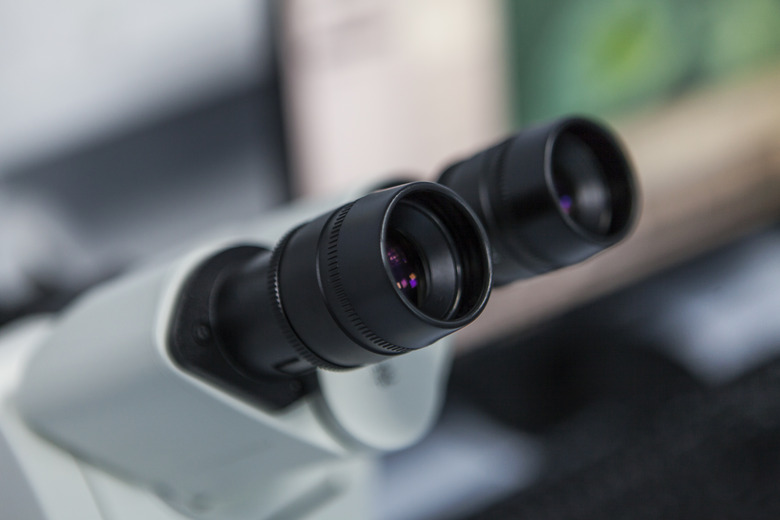How To Calculate The Field Of View In A Microscope
Compound light microscopes are valuable tools in the lab. They magnify our ability to see in detail by up to 1,000 times, allowing us to study things as small as the nucleus of a cell. With them, we can determine the shape and structure of cells, observe the movements of microorganisms, and examine the smallest parts of plants, animals and fungi. Because the objects under a microscope's view are so small, it is often impossible to use a ruler to determine their size. However, calculating a microscope's field of view (FOV), the size of the area visible through the microscope, allows you to determine the approximate size of a specimen under examination.
TL;DR (Too Long; Didn't Read)
Knowing a compound light microscope's field of view (FOV) allows you to determine the approximate size of objects too small to measure with a standard ruler. To calculate field of view, you need to know the magnification and field number of the microscope's lens currently in use. Divide the field number by the magnification number to determine the diameter of your microscope's field of view.
1. Examine Your Microscope
To determine the FOV of your microscope, first examine the microscope itself. The microscope's eyepiece should be labeled with a sequence of numbers, such as 10x/22 or 30x/18. These numbers are the eyepiece magnification and the field number, respectively. Also, take note of the magnification of your objective lens at the bottom of the microscope, if applicable – generally 4, 10, 40 or 100 times.
2. Calculating Field of View
Once you've taken note of the eyepiece magnification, field number and objective lens magnification number, if applicable, you can calculate your microscope's field of view by dividing the field number by the magnification number. For example, if the microscope's eyepiece reads 30x/18, then 18 ÷ 30 = 0.6, or an FOV diameter of 0.6 millimeters. If your microscope only uses an eyepiece, this is all you need to do, but if your microscope uses both an eyepiece and an objective lens, multiply the eyepiece magnification by the objective magnification to find the total magnification before dividing the field number. For example, if the eyepiece reads 10x/18, and the magnification of your objective lens is 40, multiply 10 and 40 to get 400. Then divide 18 by 400 to get an FOV diameter of 0.045 millimeters.
3. Changing Magnification and Measurement
Whenever you change microscopes or switch eyepieces or objective lenses, remember to repeat the FOV calculations with the new field number and magnifications. When dealing with objects observed at higher magnifications, it may be useful to convert your measurements from millimeters to micrometers. To do so, multiply the FOV diameter in millimeters by 1,000 to convert the diameter to micrometers.
Cite This Article
MLA
Flournoy, Blake. "How To Calculate The Field Of View In A Microscope" sciencing.com, https://www.sciencing.com/calculate-field-microscope-7603588/. 13 April 2018.
APA
Flournoy, Blake. (2018, April 13). How To Calculate The Field Of View In A Microscope. sciencing.com. Retrieved from https://www.sciencing.com/calculate-field-microscope-7603588/
Chicago
Flournoy, Blake. How To Calculate The Field Of View In A Microscope last modified March 24, 2022. https://www.sciencing.com/calculate-field-microscope-7603588/
